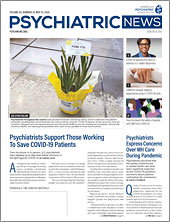A crisis, defined by the Oxford English Dictionary as a “time of intense difficulty, trouble, or danger,” can disrupt normal defense mechanisms, threatening our ability to return to our “before” functioning. The COVID-19 crisis exacerbates the stress for those with and without preexisting conditions, while impeding the means and methods used to assess and treat psychiatric illness. What role can psychotherapy play in managing this increased level of distress?
The COVID-19 world is one of parallel vulnerabilities—the “fear of contagion” versus the “contagion of fear.” At its core, fear creates anxiety and hinders our reasoning ability. The explosion of need, limited resources, and conflicting information lead to mistrust, which adds to the feelings of uncertainty. Furthermore, stay-at-home orders and the closing of schools, businesses, and so on have greatly altered the general structure of our lives. At a time when we feel most overwhelmed, we cannot “borrow” from our everyday routines for stability. Social connections are still possible but at a distance or through a video screen, which creates a sense of separation from the outside world. Absent our normal outlets, amid the extraordinary medical and psychological stress inherent in the COVID-19 pandemic, the number of people in need of psychiatric services has grown exponentially.
For our chronically ill patients, the need is even greater. The loss of regular treatment can destabilize symptoms that were previously under control. Patients with depression are more vulnerable to the losses that have occurred. Patients who already struggle with posttraumatic disorders are at greater risk, as are those who rely on a social “herd effect.” A socially anxious patient excitedly stated, “Social distancing—I am an expert! I could teach social distancing!” More recently, however, he became clinically depressed because he had relied on the social structures around him to feel connected. Now he feels neither the attachment to nor encouragement from others. The unpredictable chaos of the pandemic has worsened anxiety for patients who struggle to defend against the chance of the always possible versus the likelihood of the probable. As a result, overwhelming anxiety has mushroomed, magical thinking has prevailed, and panic may ensue.
During times of crisis, psychotherapy is generally supportive, using varying approaches that incorporate support, education, symptom relief, and “level setting.” Although this treatment tends to be time limited with short-term goals, in today’s continually shifting landscape and its uncertain time frame, end dates cannot be predetermined. Cognitive-behavioral therapy may be particularly useful in helping reset distorted schema while interpersonal therapy can focus on the role of confusion and diffusion, which are unavoidable at this time. Group therapy allows for the sharing and normalization of experience while recreating social networks that have been lost.
The core process of psychotherapy is essentially unchanged regardless of approach. The primary element is the establishment of a therapeutic alliance allowing the story to unfold and the process to go forward. Telepsychiatry provides access to care that would otherwise not be available, with numerous studies reporting outcomes equal to face-to face encounters. For telepsychiatry, there are specific ways to optimize reaching psychiatric treatment goals:
•
Create the frame: It is critical that the “frame” established in person (for example, professional workspaces, documentation of sessions, and office policies) be established equivalently in telepsychiatry. Despite current modifications to standard telemedicine, such as not having a staff member present at the exam, mimicking the in-person structure supports the psychiatrist-patient relationship, provides reassurance through consistency, and protects against the risk of informality that can distort how treatment is conducted.
•
Establish the treatment relationship: In telemedicine, the first conversation for both new and established patients demands the quick establishment or re-establishment of a relationship, obtaining important information such as an emergency contact, explaining the treatment, and inviting questions. Discomfort in the transition from in-office visits may result in initially devaluing telepsychiatry and inappropriately justifying a pause in treatment. Creating or recreating the therapeutic environment can restore the trust in psychotherapy.
•
Listen with the third (or fourth) ear: The nonverbal cues that inform us about the person we are treating, sometimes more profoundly than verbal cues, are vital for successful treatment. Ideally, telehealth should be practiced with videoconferencing, but during this crisis, many patients engage, by choice, telephonically. However, even without video access, asking patients to describe their setting and environment and acknowledging periods of silence can inform the nonverbal elements. The loss of the visual cues demands a much higher level of focus, but the anonymity can help foster the psychotherapeutic process.
Telepsychotherapy has unique advantages that enhance treatment for people coming into our virtual offices. The screens allow for a protective distance potentially encouraging patients to speak more freely about difficult subjects they feel too ashamed about to share in person. Moreover, each person chooses the place, which can help empower individuals who feel more stigmatized in the traditional office hierarchy.
The ferocity of the COVID-19 crisis, the rapidly evolving knowledge base, and ever-shifting treatment paradigms make it harder to assess risk while the unexpected change from normal health care arrangements hampers the ability to plan. Through implementation of the basic elements of good psychiatric practice while simultaneously embracing the unique elements of telemedicine, we have the ability and opportunity to provide the care that our patients—new and established—so desperately need.
On a final note, from one practitioner to another, take care and be mindful of an important air travel rule: In the event of disaster, put on your oxygen mask first before helping others put on theirs. Be aware of your “mask”; if you are having trouble managing in any way, seek help. You are essential, and your personal “mask” and need for “oxygen,” whatever forms they take, are paramount. ■

